More Advanced Eryn Examples
[1]:
import numpy as np
from eryn.ensemble import EnsembleSampler
from eryn.state import State
from eryn.prior import ProbDistContainer, uniform_dist
from eryn.moves import GaussianMove
from eryn.backends import HDFBackend
# make the plots look a bit nicer with some defaults
import matplotlib as mpl
import matplotlib.pyplot as plt
rcparams = {}
rcparams["axes.linewidth"] = 0.5
rcparams["font.family"] = "serif"
rcparams["font.size"] = 22
rcparams["legend.fontsize"] = 16
rcparams["mathtext.fontset"] = "stix"
rcparams["text.usetex"] = True
mpl.rcParams.update(rcparams) # update plot parameters
# set random seed
np.random.seed(42)
from chainconsumer import ChainConsumer
from scipy import interpolate
Searching for Gaussian pulses in 2D
In this simple example we generate a noisy figure, which contains signals in the shape of 2D Gaussian pulses. We will attempt to estimate the nubmer of signals, as well as the level of the synthetic noise. First, we generate the data.
[2]:
num = 100 # the number of step for each dimension
lowlim = -10 # Low limit on each axis
highlim = 10 # high limit on each axis
npulses = 10 # The # of injected pulses
dx = (highlim - lowlim)/num # Get the discritization
x, y = np.mgrid[lowlim:highlim:dx, lowlim:highlim:dx] # Generate the grid
Now we define the parameters of the injection signals
[3]:
Amp = np.random.uniform(.5, 1.5, size=(npulses)) # Draw an amplitude
spread = .2 # Keep their spread as fixed for simplicity.
sigma = spread * np.diag(np.ones(2))
Do the actual injection
[4]:
edges = 2 # Utility parameter, in order to avoid having signals at the border of our data set
# Draw the coordinates parameters
inj_coordinates = np.random.uniform(lowlim+edges, highlim-edges, size=(npulses, 2))
# Gather all parameters here
gauss_inj_params = [ [AA, xy[0], xy[1]] for AA, xy in zip(Amp, inj_coordinates)]
print(' * Parameters injected: \n\n', np.matrix(gauss_inj_params))
* Parameters injected:
[[ 0.87454012 -7.67064809 7.51855763]
[ 1.45071431 5.31908225 -4.60257423]
[ 1.23199394 -5.09080052 -5.06552784]
[ 1.09865848 -3.13212411 0.39610291]
[ 0.65601864 -1.0888797 -3.34033376]
[ 0.65599452 1.78964632 -5.76809823]
[ 0.55808361 -3.32568562 -2.13821051]
[ 1.36617615 -0.70288025 4.56281538]
[ 1.10111501 -4.80521949 0.22775101]
[ 1.20807258 1.4786331 -7.2567934 ]]
We then can define the model and likelihood functions
[5]:
# First we compute some constant terms of the Gaussian models (reminder: we have assumed a fixed spread for each pulse)
sigma_det = np.linalg.det(sigma)
sigma_inv = np.linalg.inv(sigma)
norm = np.sqrt((2*np.pi)**2 * sigma_det)
def gaussian_flat(x, y, a, b, c):
pos = np.empty(x.shape + (2,))
pos[:, :, 0] = x;
pos[:, :, 1] = y
mu = [b, c]
# This einsum call calculates (x-mu)T.Sigma-1.(x-mu) in a vectorized
# way across all the input variables.
fac = np.einsum('...k,kl,...l->...', pos-mu, sigma_inv, pos-mu)
return a * np.exp(- fac / 2) / norm
def gaussian(X, Y, a, b, c):
x = X[:,0]
y = Y[0,:]
# breakpoint()
A = np.exp(-((x[:, None] - b) ** 2) / (2 * sigma[0,0]))
B = np.exp(-((y[:, None] - c) ** 2) / (2 * sigma[1,1]))
# breakpoint()
C = A*B[:,None,:] # (np.expand_dims(A,axis=0) * np.expand_dims(np.transpose(B),axis=2))
return np.transpose( a * C / norm , axes=(1,0,2))
def log_prob_fn(x, groups, X, Y, data, inds=None, fill_inds=[], fill_values=None):
x1, x2 = x
group1, group2 = groups
a = x1[:, 0]
b = x1[:, 1]
c = x1[:, 2]
n = num * num
gauss_out = gaussian(X, Y, a, b, c)
num_groups = int(group1.max() + 1)
template = np.zeros((num_groups, num, num))
for i in range(num_groups):
inds1 = np.where(group1 == i)
given_signal = gauss_out[:,:,inds1].squeeze().sum(axis=-1)
template[i] += given_signal
sig = np.atleast_2d(x2)[:,0]
llh = - 0.5 * ( np.sum(((template - data)) ** 2, axis=(1, 2)) )
llh *= 1/sig**2
llh += - n*np.log(sig) - .5 * n * np.log(2.*np.pi)
return llh
We then generate the noise and add our injections.
[6]:
sigma_noise = [[0.2]] # The nosie variance
noise = sigma_noise[0][0] * np.random.randn( num, num ) # Draw the random points for the noise
# Generate the data-set
injection = np.zeros( (num, num) )
for params in gauss_inj_params:
injection += gaussian_flat(x, y, *params)
data = injection + noise
params = np.array(gauss_inj_params)
Plot everything below
[7]:
from matplotlib import cm
plt.figure(figsize=(17,7))
plt.subplot(121)
cf = plt.contourf(x, y, injection, 10, cmap=cm.PuBu)
plt.scatter(params[:,1], params[:,2], marker='x', color='#DC143C')
plt.colorbar(cf)
plt.xlabel(r'$x$')
plt.ylabel(r'$y$')
plt.subplot(122)
cf = plt.contourf(x, y, data, 10, cmap=cm.PuBu)
plt.scatter(params[:,1], params[:,2], marker='x', color='#DC143C')
plt.xlabel(r'$x$')
plt.ylabel(r'$y$')
plt.colorbar(cf)
plt.show()
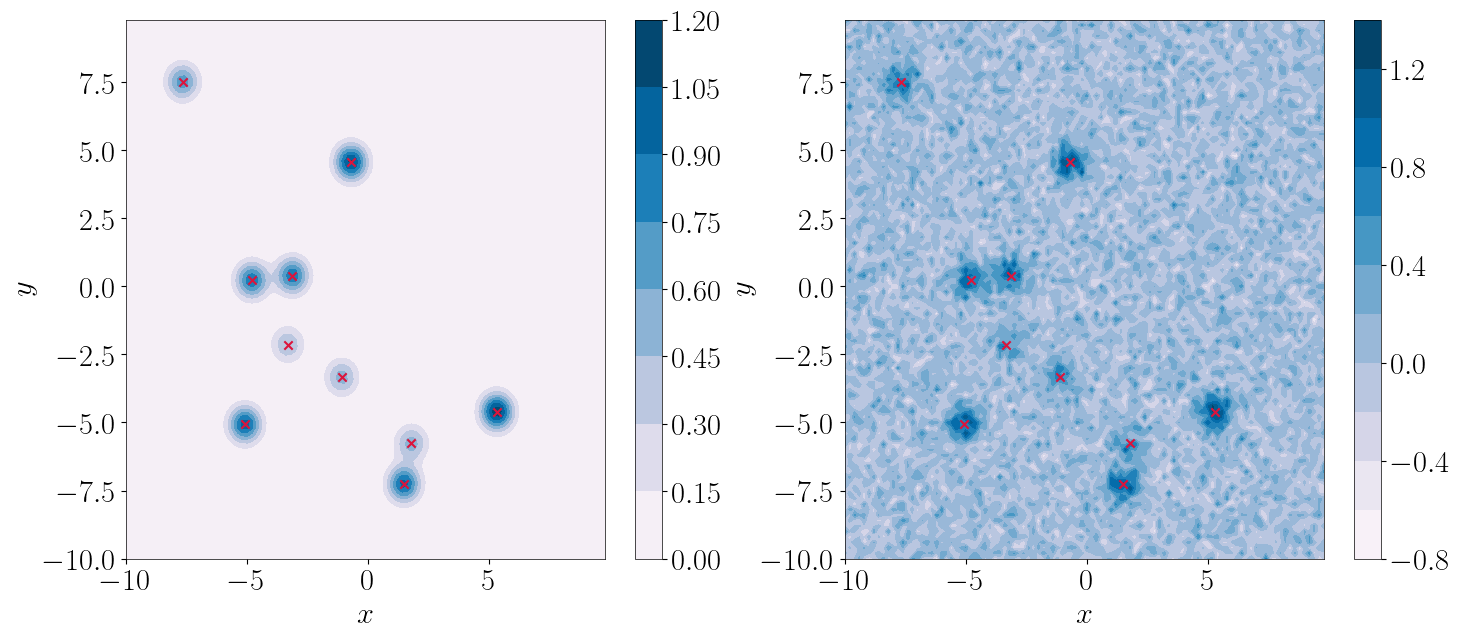
We then need to configure models and set-up our sample, in a very similar manner as we did for the simpler case before. Like in the previous case, we have two models that we need to sample for. One refers to the pulse signals, which we need to also estimate their total number in the data, and the other is the overal noise (no dynamical parameter space here).
[8]:
ndims = [3, 1] # The dimensions of the two models we sample for here (# of parameter for each pulse, and # of parameters for the noise)
nleaves_max = [2*npulses, 1] # Maximum number of components for each model type (noise is 1, because we don't want to use RJ MCMC on it).
branch_names = ["pulse", "noise"]
priors = {
"pulse": {
0: uniform_dist(0.5, 2.),
1: uniform_dist(lowlim, highlim),
2: uniform_dist(lowlim, highlim),
},
"noise": {
0: uniform_dist(0.000001, 2.),
}
}
Below we generate the coordinates for each walker, as done before. First we need to define the number of Temperatures and walkers we want to use.
[9]:
ntemps = 10
nwalkers = 30
[10]:
coords = {
name: np.zeros((ntemps, nwalkers, nleaf, ndim))
for nleaf, ndim, name in zip(nleaves_max, ndims, branch_names)
}
sig1 = 0.0000001
for nleaf, ndim, name in zip(nleaves_max, ndims, branch_names):
for nn in range(nleaf):
if name == "pulse":
if nn >= len(gauss_inj_params):
kk = np.random.randint(low=0, high=npulses)
else:
kk = nn
coords[name][:, :, kk] = np.random.multivariate_normal(gauss_inj_params[kk], np.diag(np.ones(3) * sig1), size=(ntemps, nwalkers))
else:
coords[name][:, :, nn] = np.random.multivariate_normal(sigma_noise[nn], np.diag(np.ones(1) * sig1), size=(ntemps, nwalkers))
inds = {
name: np.random.randint(low=0, high=1, size=(ntemps, nwalkers, nleaf), dtype=bool)
for nleaf, name in zip(nleaves_max, branch_names)
}
inds['pulse'][:, :, :3] = True
for name, inds_temp in inds.items():
inds_fix = np.where(np.sum(inds_temp, axis=-1) == 0)
for ind1, ind2 in zip(inds_fix[0], inds_fix[1]):
inds_temp[ind1, ind2, 0] = True
groups = {
name: np.arange(coords[name].shape[0] * coords[name].shape[1]).reshape(
coords[name].shape[:2]
)[:, :, None]
for name in coords
}
groups = {
name: np.repeat(groups[name], coords[name].shape[2], axis=-1) for name in groups
}
coords_in = {name: coords[name][inds[name]] for name in coords}
groups_in = {name: groups[name][inds[name]] for name in groups}
# We compute the initial likelihood value at the injected coordinates:
log_prob = log_prob_fn(
[coords_in["pulse"], coords_in["noise"]],
[groups_in["pulse"], groups_in["noise"]],
x,
y,
data,
fill_inds=[],
fill_values=None,
)
What remains is to sample the dynamical parameter space! One last thing: Define proposal and initial temperature ladder:
[11]:
factor = 0.0001
cov = {"pulse": np.diag(np.ones(3)) * factor,
"noise": np.diag(np.ones(1)) * factor}
moves = GaussianMove(cov)
betas = np.linspace(1.0, 0.0, ntemps)
Begin sampling. This might take a while, so you can reduce the burnin and nsteps to get a quick result. With current settings it ight take between 2 - 5 minutes.
[12]:
ensemble = EnsembleSampler(
nwalkers,
ndims, # assumes ndim_max
log_prob_fn,
priors,
args=[x, y, data],
tempering_kwargs=dict(betas=betas),
nbranches=len(branch_names),
branch_names=branch_names,
nleaves_max=nleaves_max,
provide_groups=True,
update_iterations=1,
plot_iterations=-1,
vectorize=True,
moves=moves,
rj_moves=True,
)
nsteps = 500 # Number of samples per walker
state = State(coords, log_like=log_prob.reshape(ntemps, nwalkers), betas=betas, blobs=None, inds=inds)
ensemble.run_mcmc(state, nsteps, burn=100, progress=True, thin_by=1)
100%|██████████| 100/100 [00:14<00:00, 7.01it/s]
100%|██████████| 500/500 [02:26<00:00, 3.41it/s]
[12]:
<eryn.state.State at 0x7ff61a97edc0>
We then plot the results below
[13]:
def get_clean_chain(coords, ndim, temp=0):
"""Simple utility function to extract the squeezed chains for all the parameters
"""
naninds = np.logical_not(np.isnan(coords[:, temp, :, :, 0].flatten()))
samples_in = np.zeros((coords[:, temp, :, :, 0].flatten()[naninds].shape[0], ndim)) # init the chains to plot
# get the samples to plot
for d in range(ndim):
givenparam = coords[:, temp, :, :, d].flatten()
samples_in[:, d] = givenparam[
np.logical_not(np.isnan(givenparam))
] # Discard the NaNs, each time they change the shape of the samples_in
return samples_in
[14]:
pulse_parameters = ["$A$", r"$x$", r"$y$"]
noise_parameters = ["$\sigma_\mathrm{noise}$"]
samples_pulses = get_clean_chain(ensemble.backend.get_chain(thin=1)['pulse'], ndims[0])
samples_noise = get_clean_chain(ensemble.backend.get_chain(thin=1)['noise'], ndims[1])
[15]:
c = ChainConsumer()
c.add_chain(samples_pulses, parameters=pulse_parameters, name='Pulses', color='#6495ed')
c.configure(bar_shade=True, tick_font_size=8, label_font_size=12, max_ticks=8, usetex=True, serif=True)
for ii in range(npulses):
c.add_marker([gauss_inj_params[ii][0], gauss_inj_params[ii][1], gauss_inj_params[ii][2]], \
parameters=pulse_parameters, marker_style="x", \
marker_size=100, color='#DC143C')
fig = c.plotter.plot(figsize=(8,8), legend=False);
WARNING:chainconsumer:Configure has been called 2 times - this is not good - it should be once!
WARNING:chainconsumer:To avoid this, load your chains in first, then call analysis/plotting methods
WARNING:chainconsumer:Parameter $A$ in chain Pulses is not constrained
WARNING:chainconsumer:Parameter $x$ in chain Pulses is not constrained
WARNING:chainconsumer:Parameter $y$ in chain Pulses is not constrained
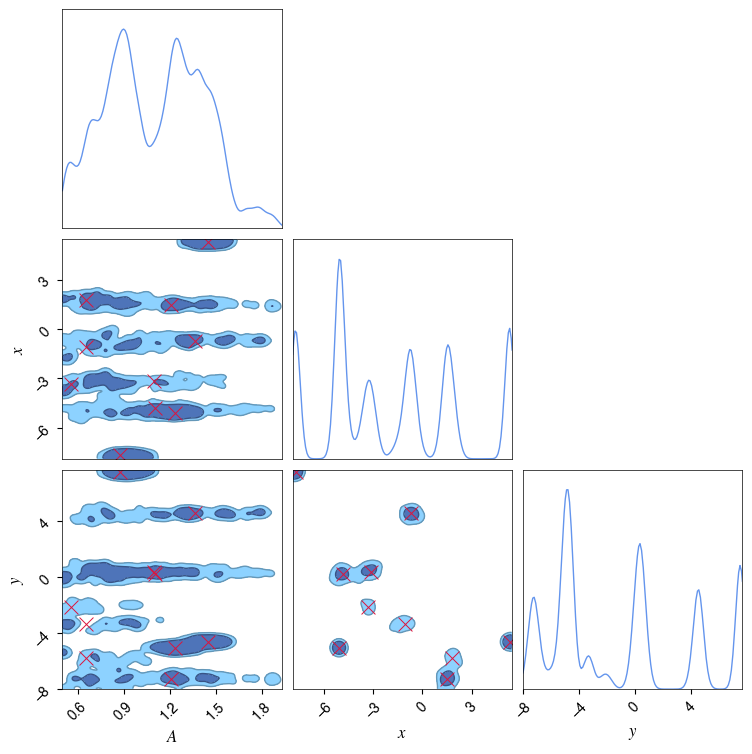
[16]:
c = ChainConsumer()
c.add_chain(samples_noise, parameters=noise_parameters, name='noise', color='orange')
c.configure(bar_shade=True, tick_font_size=8, label_font_size=12, max_ticks=8, usetex=True, serif=True)
fig = c.plotter.plot(figsize=(4,4), legend=False, truth=sigma_noise[0]);
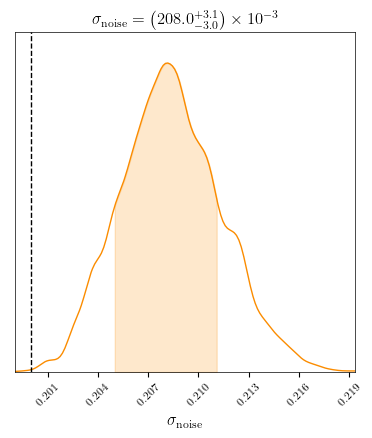
[17]:
def get_clean_k_chains(backend, temp=0):
""" A simple function to get the chains of model order k
Args:
backend: The Eryn backend
Returns:
k_chain: the chains of the k order
"""
inds = backend.get_value("inds") # Get the leaves out
branches = {name: np.sum(inds[name], axis=-1, dtype=int) for name in inds}
for (branch) in (branches): # Get the total number of components/branches per temperature
if branch == list(branches.keys())[0]:
k_chain = branches[branch][:, temp].flatten()
else:
k_chain += branches[branch][:, temp].flatten()
return k_chain
[18]:
gauss_k_chain_baseline = get_clean_k_chains(ensemble.backend)
bns = (np.arange(1, nleaves_max[0] + 2) - 0.5) # Get maximum allowed number of leaves for the given branch
fig = plt.figure(figsize=(5, 5))
plt.hist(
gauss_k_chain_baseline-1,
bins=bns,
color='#6495ed',
alpha=0.9,
lw=2,
histtype='step',
density=True,
hatch='///'
)
plt.axvline(x=int(npulses), linestyle='--', lw=2, color='#DC143C')
plt.xticks(fontsize=12)
plt.yticks([])
plt.xlim(1, 20)
plt.xlabel("$\#$ of peaks in the data")
plt.show()
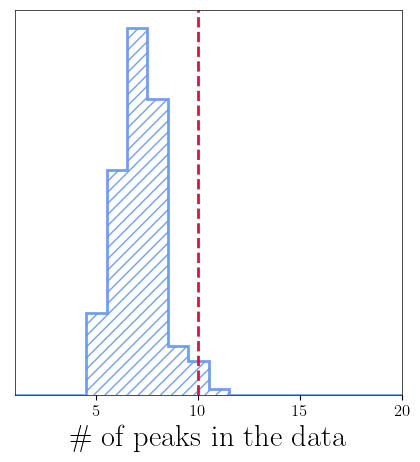
Choosing the optimal B-Spline order
In this section we will attempt to fit a spectrum using a shape-agnostic model based on B-spline interpolation. The motivation of the problem is to determine the optimal number of free knots that are best describing the data, avoiding over-fitting situations. A very useful package is this one, which is a simple package for performing spectral analysis. Has a lot of window functions, but more importantly, it contains the log-PSD function, which we will
use in order to reduce the computational complexity of the problem. For more invormation about the lpsd method you can check this paper.
First we set-up the type of measurement. The duration, cadence, also try to define the total number of steps for our sampler.
[19]:
Tobs = 1e6 # Duration of data
dt = 10 # Delta-t [s]
fs = 1/dt # Sampling frequency
Ndata = int(Tobs/dt) # Number of data points
tvec = np.arange(0, Tobs, dt) # Get the time vector
df = 1.0/Tobs # Define Delta-f
burnin=1000
nsteps=2000
We then need to simulate some time-series. We could totally do this directly in frequency domain, but we will generate synthetic time series in order to use the lpsd function, which is useful for now. We start by defining our “true”, or “theoretical” PSD of the data, which we will use to generate our data-set.
[20]:
if (Ndata % 2)==0: # Get the number of requencies
nfft = int((Ndata/2)+1)
else:
nfft = int((Ndata+1)/2)
F = df*nfft # make the positive frequency vector
fvec = np.arange(0, F, df)
# Define a smooth model for the PSD of the noise
fstar=8e-3
n1=-5
n2=5
amp = 1
noisemodel = lambda f : 1e-3/f + 50*f + amp * (f**(n1 + n2) / (fstar**n1 * f**n2 + fstar**n2 * f**n1) )
# Get the PSD of the noise using hte model above
Sn = noisemodel(fvec)
# Remove first nan (assume also zero-mean)
Sn[0] = 0
/var/folders/yz/xf637mpx56g2dvdv9d8v1fnm0000gn/T/ipykernel_3250/1282363938.py:14: RuntimeWarning: divide by zero encountered in true_divide
noisemodel = lambda f : 1e-3/f + 50*f + amp * (f**(n1 + n2) / (fstar**n1 * f**n2 + fstar**n2 * f**n1) )
/var/folders/yz/xf637mpx56g2dvdv9d8v1fnm0000gn/T/ipykernel_3250/1282363938.py:14: RuntimeWarning: divide by zero encountered in power
noisemodel = lambda f : 1e-3/f + 50*f + amp * (f**(n1 + n2) / (fstar**n1 * f**n2 + fstar**n2 * f**n1) )
Import the spectral module for convenience. It contains tons of windows and some spectral utility functions.
[21]:
from spectral import genTimeSeriesFromPSD, lpsd, welchpsd
We generate the time-series by ifft-ing from the PSD model we provided. We then compute the PSD of the data using hte Welch method.
[22]:
navs = 30
## Generate time-series here
print('\n # Generating noisy data with \n\t Tobs: {} \n\tNdata: {} \n\t dt: {} \n\t df: {}\n\t '.format(Tobs, Ndata, dt, df))
my_data = genTimeSeriesFromPSD(Sn,fs) # I divide by two because the function assumes the 2-sided spectrum
f20, S20 = welchpsd(my_data, fs, int(Ndata/navs), win='nuttall4c')
fr1, S1 = welchpsd(my_data, fs, Ndata, win='nuttall4c')
# Generating noisy data with
Tobs: 1000000.0
Ndata: 100000
dt: 10
df: 1e-06
In order to save some computatational time, we use the lpsd method, which is basically a method to compute the PSD of time-series, using the optimal number of averages at each frequeny. The frequency grid is equally spaced in log, and pre-defined. For more information, you can tcheck this paper.
[23]:
f0 = 1e-4
f1 = 5e-2
fl, Sl, Sle, _, Kavs = lpsd(my_data, fs, Kdes=100, Jdes=200, flims=[f0, f1], win='nuttall4b', winalpha=0., olap=0.0, order=0, errrype='std', DOPLOT=False, VERBOSE=False)
errs = [np.absolute(Sle[0]), np.absolute(Sle[1])]
[35]:
plt.figure(figsize=(12,5))
plt.loglog(fr1, S1, label='Numerically calculated PSD, with N=1', color='grey', alpha=.3)
plt.loglog(f20, S20, label=f'Numerically calculated PSD, with N={navs}', color='cornflowerblue')
plt.errorbar(fl, np.absolute(Sl), yerr=errs, fmt='.', label='logPSD', color='crimson')
plt.loglog(fvec, Sn, alpha=0.5, color='k', linewidth=3, label='My PSD theoretical model')
plt.xlim(1e-5, fvec[-1])
plt.ylim(1e-3, 1e2)
plt.ylabel('[1/Hz]')
plt.xlabel('Frequency [Hz]')
plt.legend(loc='lower left')
[35]:
<matplotlib.legend.Legend at 0x7ff62dd829d0>
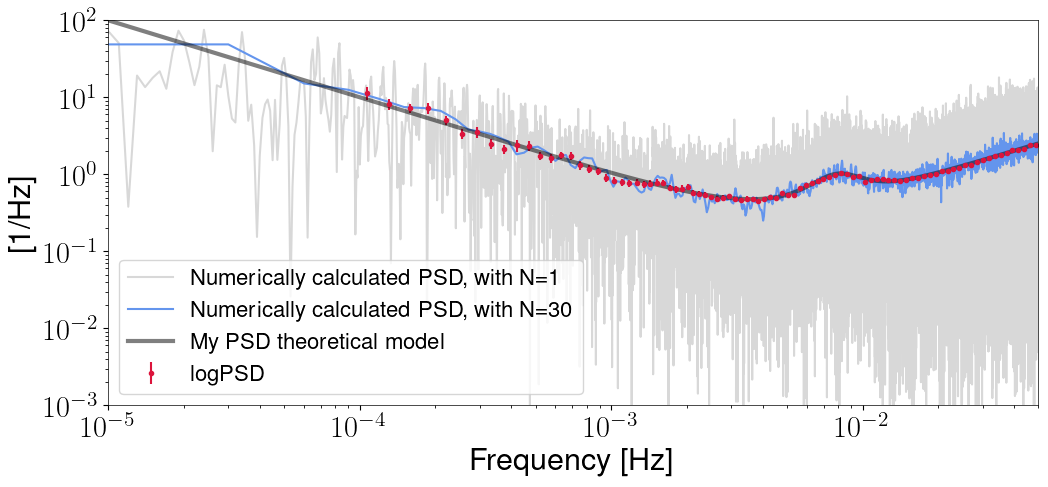
Now we setting up the sampler.
[25]:
maxmodels = 20
ntemps = 10
nwalkers = 10
backendname = 'a_test'
For this investigation, we need two models. One model concerns the knots at the edges of the spectrum, which we only do parameter estimation for their respective amplitude. So, no reversible jump for this one. We do this by simply setting the maximum number of leaves to 1. The second model is the one that is dynamic, each component having an amplitude and a position parameter. We call those models edges and knots respectively.
[26]:
ndims = [2, 2] # The first is control point + knot, the second two control points (knots are the edges)
nleaves_max = [maxmodels, 1]
nleaves_min = [2, 1]
branch_names = ["knots", "edges"]
# Restrict the frequency band
i_band = np.where((fl>=f0) & (fl<=f1))[0]
mx = np.max(np.log(noisemodel(fl[i_band])))
mn = np.min(np.log(noisemodel(fl[i_band])))
print('max:', mx)
print('min:', mn)
#The prior on the knot amplitude could be dependent on the frequency, but I choose
#to be simple here
priors = {
"knots": {
0: uniform_dist(np.log(f0), np.log(f1)),
1: uniform_dist(1.5*mn, 1.2*mx),
},
"edges": {
0: uniform_dist(1.5*mn, 1.2*np.log(noisemodel(fl[0]))),
1: uniform_dist(1.5*mn, 1.3*np.log(noisemodel(fl[-1]))),
}
}
max: 2.2400506683151953
min: -0.7418475507541406
Setting up the input coordinates. This might be easier in the future, but hte functionality should remain.
[27]:
# Initialize the knots fr,
coords = {
name: np.zeros((ntemps, nwalkers, nleaf, ndim))
for nleaf, ndim, name in zip(nleaves_max, ndims, branch_names)
}
sig1 = 0.0001
for nleaf, ndim, name in zip(nleaves_max, ndims, branch_names):
print('# {}: Max models = {}, dim = {}'.format(name, nleaf, ndim))
for nn in range(nleaf):
if name == "knots":
for dd in range(ndim):
coords[name][:, :, nn, dd] = priors['knots'][dd].rvs(size=(ntemps,nwalkers))
else:
for dd in range(ndim):
coords[name][:, :, nn, dd] = priors['edges'][dd].rvs(size=(ntemps,nwalkers)) # np.random.multivariate_normal(edges_starting_params[nn], np.diag(np.ones(2) * sig1), size=(ntemps, nwalkers))
indxs = {
name: np.random.randint(low=0, high=1, size=(ntemps, nwalkers, nleaf), dtype=bool)
for nleaf, name in zip(nleaves_max, branch_names)
}
indxs['knots'][:, :, :3] = True
for name, inds_temp in indxs.items():
inds_fix = np.where(np.sum(inds_temp, axis=-1) == 0)
for ind1, ind2 in zip(inds_fix[0], inds_fix[1]):
inds_temp[ind1, ind2, 0] = True
groups = {
name: np.arange(coords[name].shape[0] * coords[name].shape[1]).reshape(
coords[name].shape[:2]
)[:, :, None]
for name in coords
}
groups = {
name: np.repeat(groups[name], coords[name].shape[2], axis=-1) for name in groups
}
coords_in = {name: coords[name][indxs[name]] for name in coords}
groups_in = {name: groups[name][indxs[name]] for name in groups}
# knots: Max models = 20, dim = 2
# edges: Max models = 1, dim = 2
Now we need to define the likelihood function. It hadles
[28]:
class SplineLikelihood:
def __init__(self, freq, per, N, inf=1e14, expmax = 500, kind='cubic', ftol=.1):
"""
Gaussian likelihood model using a log-periodogram.
Parameters
----------
fr : (ndarray) frequency array of the estimation domain, size nf
per : (ndarray) periodogram array, size nf
N : (ndarray) array of averages per frequency, size nf
var : (float) variance of the log-periodogram bins
inf : (float or np.inf) if the likelihood diverges, it will be set equal to - inf
expmax : (float) maximum value allowed in the exponential function. If this is reached, the log-likelihood will return -infinity.
kind : (string) Interpolation kind. Set to 'cubic' by default.
ftol : (float [ 0 < ftol]) Tolerance on proximity of knots in logspace
"""
# Frequency of data
self.freq = freq
self._Nsegs = N
self._N = len(freq)
self.logfr = np.log(freq)
# Discrete Fourier transform of data (already normalized)
self.per = per
# Maximum value allowed in the exponential function
self.expmax = expmax
# Interpolation kind
self.kind = kind
# tolerance on proximity of knots in logspace
self.ftol = ftol
self.inf = inf
def get_noise_psd_model(self, x, groups):
"""Get the spline model for the noise PSD, given some knots
Parameters
----------
x, groups : (ndarray) PSD parameters
Returns
-------
psd_model : interpolate.interp1d evaluated
"""
# I will consider two models. One handling the internal knots, and one for the edges
internal_knots_parameters, control_points_edges = x
group1, group2 = groups
knots = internal_knots_parameters[:, 0]
control_points = internal_knots_parameters[:, 1]
num_groups = int(group1.max() + 1)
# log_psd_model = np.zeros((num_groups, len(self.freq)))
log_psd_model = np.empty((num_groups, len(self.freq)))
log_psd_model[:] = np.nan
# Loop over the temperatures vs walkers
for i in range(num_groups):
inds1 = np.where(group1 == i)
knots_i = knots[inds1]
control_points_i = control_points[inds1]
inds2 = np.where(group2 == i)
control_points_edges_i = np.squeeze(control_points_edges[inds2])
# Remove zeros
knots_i = knots_i[knots_i != 0.]
control_points_i = control_points_i[control_points_i != 0.]
knots_list = np.array([self.logfr[0]] + list(knots_i) + [self.logfr[-1]])
control_pts = np.array([control_points_edges_i[0]] + list(control_points_i) + [control_points_edges_i[-1]])
# Control for knots very close to each other
if not np.any(np.diff(np.array(knots_list)) < self.ftol):
# Change the data and reset the spline class
interp_model = interpolate.interp1d(knots_list, control_pts,
kind=self.kind, axis=-1, copy=True,
bounds_error=False,
fill_value="extrapolate",
assume_sorted=False)
log_psd_model[i] = interp_model(self.logfr)
# To prevent overflow
if np.any(log_psd_model[i] > self.expmax):
print('[Overflow!]')
i_over = np.where((log_psd_model[i] > self.expmax) | (np.isnan(log_psd_model[i])))
log_psd_model[i][i_over] = np.nan
# Return the correct quantity
return np.exp(log_psd_model)
def evaluate(self, x, groups):
"""
Calculate the log-likelihood.
Parameters
----------
x : (ndarray) vector of spline parameters.
groups : (ndarray) vector of groups parameters.
Returns
-------
L : (ndarray) log-likelihood value at x, groups computed.
"""
# Compute PSD model
C = self.get_noise_psd_model(x, groups)
# Get the normalisation constants
log2pi = - self._N * np.log(2.0*np.pi)
# Log-likelihood calculation
L = -1.* self.per / C
# Sum with the normalization factor here
L = np.nan_to_num(.5 * self._Nsegs * ( L - np.log(C) + log2pi), nan= -np.inf)
L = np.sum(L, axis=-1)
L[~np.isfinite(L)] = -self.inf
return L
[29]:
# Instantiate and initalize likelihood again with different ftol
psdlike = SplineLikelihood(fl[i_band].squeeze(), np.real(Sl[i_band]), Kavs[i_band], ftol=.05)
liekeval = psdlike.evaluate([coords_in["knots"], coords_in["edges"]], [groups_in["knots"], groups_in["edges"]])
print('llh shape = ', liekeval.shape)
print('liekeval = ', liekeval)
log_prob = liekeval.reshape(ntemps, nwalkers)
llh shape = (100,)
liekeval = [-4.29905751e+06 -1.00000000e+14 -1.00000000e+14 -1.00000000e+14
-1.00000000e+14 -1.00000000e+14 -1.00000000e+14 -1.00000000e+14
-4.37617254e+06 -1.00000000e+14 -1.00000000e+14 -1.00000000e+14
-1.00000000e+14 -1.00000000e+14 -1.00000000e+14 -1.00000000e+14
-4.30751294e+06 -4.31923024e+06 -1.00000000e+14 -1.00000000e+14
-1.00000000e+14 -1.00000000e+14 -1.00000000e+14 -1.00000000e+14
-1.00000000e+14 -1.00000000e+14 -1.00000000e+14 -1.00000000e+14
-4.31360092e+06 -1.00000000e+14 -1.00000000e+14 -1.00000000e+14
-1.00000000e+14 -1.00000000e+14 -1.00000000e+14 -1.00000000e+14
-1.00000000e+14 -1.00000000e+14 -1.00000000e+14 -1.00000000e+14
-1.00000000e+14 -1.00000000e+14 -1.00000000e+14 -1.00000000e+14
-1.00000000e+14 -1.00000000e+14 -1.00000000e+14 -1.00000000e+14
-1.00000000e+14 -1.00000000e+14 -1.00000000e+14 -1.00000000e+14
-1.00000000e+14 -1.00000000e+14 -1.00000000e+14 -1.00000000e+14
-1.00000000e+14 -1.00000000e+14 -1.00000000e+14 -1.00000000e+14
-1.00000000e+14 -1.00000000e+14 -1.00000000e+14 -1.00000000e+14
-1.00000000e+14 -1.00000000e+14 -1.00000000e+14 -1.00000000e+14
-1.00000000e+14 -1.00000000e+14 -1.00000000e+14 -1.00000000e+14
-1.00000000e+14 -1.00000000e+14 -1.00000000e+14 -1.00000000e+14
-1.00000000e+14 -1.00000000e+14 -1.00000000e+14 -1.00000000e+14
-1.00000000e+14 -1.00000000e+14 -1.00000000e+14 -1.00000000e+14
-4.32508567e+06 -1.00000000e+14 -4.45639724e+06 -1.00000000e+14
-1.00000000e+14 -1.00000000e+14 -4.46121449e+06 -1.00000000e+14
-1.00000000e+14 -1.00000000e+14 -1.00000000e+14 -1.00000000e+14
-1.00000000e+14 -1.00000000e+14 -1.00000000e+14 -1.00000000e+14]
Now run the sampler!
[30]:
betas = np.linspace(1.0, 0.0, ntemps)
factor = 0.0001
cov = {"knots": np.diag(np.ones(2)) * factor,
"edges": np.diag(np.ones(2)) * factor}
moves = GaussianMove(cov)
backend = HDFBackend(backendname + ".h5")
ensemble = EnsembleSampler(
nwalkers,
ndims, # assumes ndim_max
psdlike.evaluate,
priors,
args=None,
tempering_kwargs=dict(betas=betas),
nbranches=len(branch_names),
branch_names=branch_names,
nleaves_max=nleaves_max,
nleaves_min=nleaves_min,
provide_groups=True,
update_iterations=1,
plot_iterations=-1,
moves=moves,
rj_moves=True,
vectorize=True,
backend=backend,
)
print(' * Started sampling ...')
state = State(coords, log_like=log_prob, betas=betas, blobs=None, inds=indxs)
ensemble.run_mcmc(state, nsteps, burn=burnin, progress=True, thin_by=1)
print(' * Finished sampling!')
* Started sampling ...
18%|█▊ | 184/1000 [00:03<00:15, 53.85it/s]/var/folders/yz/xf637mpx56g2dvdv9d8v1fnm0000gn/T/ipykernel_3250/1577252010.py:111: RuntimeWarning: divide by zero encountered in true_divide
L = -1.* self.per / C
/var/folders/yz/xf637mpx56g2dvdv9d8v1fnm0000gn/T/ipykernel_3250/1577252010.py:111: RuntimeWarning: overflow encountered in true_divide
L = -1.* self.per / C
/var/folders/yz/xf637mpx56g2dvdv9d8v1fnm0000gn/T/ipykernel_3250/1577252010.py:114: RuntimeWarning: divide by zero encountered in log
L = np.nan_to_num(.5 * self._Nsegs * ( L - np.log(C) + log2pi), nan= -np.inf)
/var/folders/yz/xf637mpx56g2dvdv9d8v1fnm0000gn/T/ipykernel_3250/1577252010.py:114: RuntimeWarning: invalid value encountered in subtract
L = np.nan_to_num(.5 * self._Nsegs * ( L - np.log(C) + log2pi), nan= -np.inf)
/Users/nikos/work/programs/anaconda3/lib/python3.9/site-packages/numpy/core/fromnumeric.py:86: RuntimeWarning: overflow encountered in reduce
return ufunc.reduce(obj, axis, dtype, out, **passkwargs)
61%|██████ | 612/1000 [00:11<00:07, 51.11it/s]/var/folders/yz/xf637mpx56g2dvdv9d8v1fnm0000gn/T/ipykernel_3250/1577252010.py:114: RuntimeWarning: overflow encountered in multiply
L = np.nan_to_num(.5 * self._Nsegs * ( L - np.log(C) + log2pi), nan= -np.inf)
100%|██████████| 1000/1000 [00:19<00:00, 52.54it/s]
46%|████▌ | 911/2000 [00:27<00:32, 33.08it/s]
[Overflow!]
100%|██████████| 2000/2000 [01:00<00:00, 33.08it/s]
* Finished sampling!
[31]:
baseline_run_backend = HDFBackend(backendname + ".h5") # Load the data from disk
[32]:
temp = 0
ndim_knots = 2 # Set the dimensionality of each model
ndim_edges = 2
samples_knots = get_clean_chain(baseline_run_backend.get_chain()['knots'], ndim_knots)
samples_edges = get_clean_chain(baseline_run_backend.get_chain()['edges'], ndim_edges)
Plot the “squeezed” posterior surface for our parameters, for all k models.
[33]:
paramnames = [r'$\log f_{j,k}$',r'$\log S_{j,k}$'] # Define parameter names
i_band = np.where((f20>=f0) & (f20<=f1))[0] # Keep only the range which we fitted in
c = ChainConsumer()
c.add_chain(samples_knots, parameters=paramnames, name='Knots in-between', color='orange')
c.configure(bar_shade=True, plot_hists=False)
fig = c.plotter.plot(figsize=(4, 4));
ff = np.linspace(np.log(f20[i_band][0]),np.log(f20[i_band][-1]), num=1000)
ax_list = fig.axes
ax_list[0].plot(ff, np.log(noisemodel(np.exp(ff))), color='k', lw=1.5,linestyle='--')
plt.show()
mpl.rcParams['text.usetex']=True # Update this becasue chaincnsumer is annoyinh
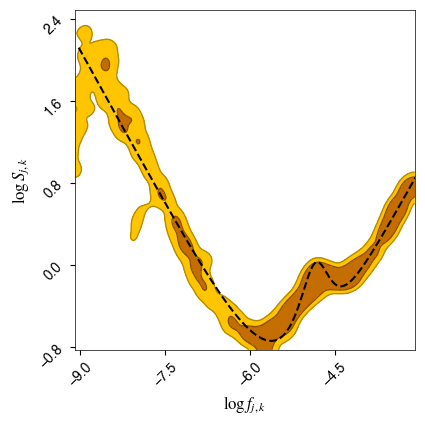
[34]:
knots_k_chain = get_clean_k_chains(baseline_run_backend)
bns = (np.arange(1, maxmodels + 2) - 0.5) # Get maximum allowed number of leaves for the given branch
mpl.rcParams['text.usetex']=True # Update this becasue chaincnsumer is annoying
fig = plt.figure(figsize=(6, 6))
probs, bins, rects = plt.hist(
knots_k_chain-1,
bins=bns,
facecolor=None,
histtype='step',
edgecolor='orange',
hatch='////',
alpha=1,
lw=2,
density=True,
label='knots in-between'
)
plt.legend(loc='upper left')
plt.xticks(np.arange(0, maxmodels))
plt.xlim(0, 11)
plt.xlabel(r"$\#$ of free knots")
[34]:
Text(0.5, 0, '$\\#$ of free knots')
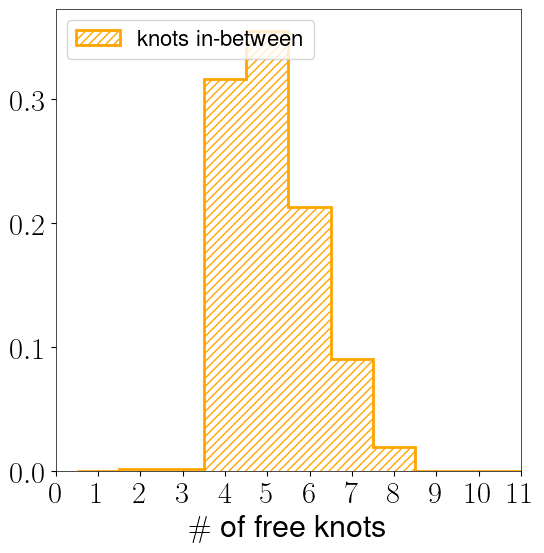
\(\sim fin \sim\)